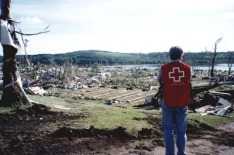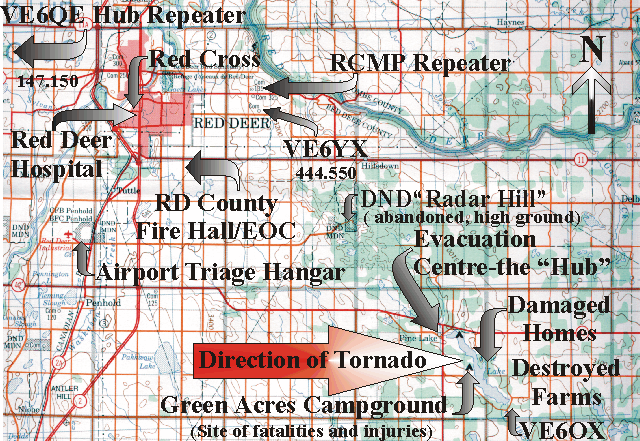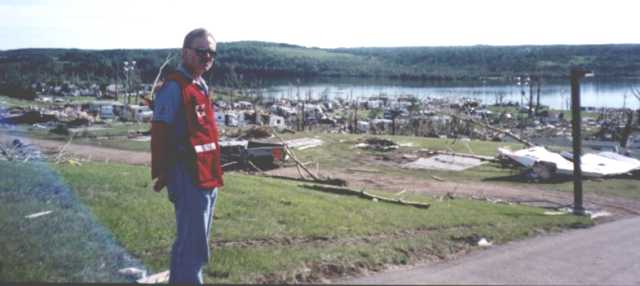| Most roads that lead from Highway 42 (the direct route from Red Deer) to the campground were across the tornado’s path and littered with debris and overturned vehicles. Vehicular traffic responding to the disaster site was highly congested and immediately blocked by the RCMP.
Cellular phone service into Pine Lake was extremely limited. Only one cell network, Telus, had any coverage in the area and reportedly only 20 channels were available the night of the tornado. The cell site was instantly saturated and stayed that way for days.
Emergency Net Control – VE6BLD Bob King – The first 8 – 48 hours
| Bob King VE6BLD handled Net Control during the first 8 hours of the Pine Lake Tornado.His well equipped station in Lacombe, Alberta was able to work all frequencies in use at Pine Lake throughout the night.
Minutes after notification, Bob King VE6BLD established net control on the VE6QE hub for the Central Alberta Repeater VHF Network from his home in Lacombe, Alberta. Bob started calling out amateur radio operators from throughout the region, and assigned them to the tasks where their individual skills would be most useful. |
 |
|
photos courtesy Bob King |
| To some of Bob’s neighbors, his amateur radio tower and antennas may be an esthetic nightmare, but to the Red Cross staff and volunteers at the Pine Lake Tornado site the antennas pictured here were a communications life line. Both landline and cellular telephone systems were overloaded and unusable within minutes of the tornado at Pine Lake.
Bob’s amateur radio site was able to communicate directly with the Pine Lake Tornado site 30km southeast of Lacombe (line of sight distance). Bob also had direct contact with Red Cross amateur radio operators in Red Deer, Edmonton, and if needed Calgary |
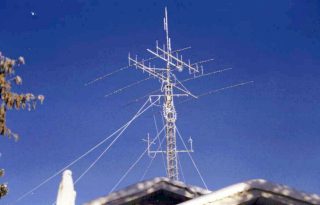 |
| Emergency Traffic handled by Net Control (as summarized from net control logs) |
|
| The emergency net unofficially went on air at approximately half an hour after the tornado touched down. Bob King VE6BLD, Garry McCallum VE6PNQ and Mike Mailhiot VE6MIM all began responding to a variety of external information sources such as weather alert radios, abnormal activity on scanners, abnormal ambulance activity on Highway 2 and knowledge of regional hospital call outs. It was through unofficial communications back channels such as monitoring RCMP communications that it became clear that regular communications channels were going to have extreme problems in the Pine Lake area. Red Deer amateurs quietly began responding.
It was over an hour later that official call out systems began notifying the Red Cross amateur radio operators of the emergency. In some cases amateurs were called out 3 hours after arriving on site at Pine Lake.
By approximately 2015 (tornado touchdown plus 1 hour) official callouts started to reach assistant RAC Emergency Coordinator Darren Misik VE6ZZM and Bob King was instructed to assume formal Net Control and declare an emergency net operation. This requires that all other amateur radio operations in the area cease immediately. Net control (VE6BLD) began to check in all available amateur radio operators, assess their locations, resources and potential response times. Many were already on the air due to the unofficial traffic. Telephone call outs were also followed up.
By 2045 Net control (VE6BLD) and Emergency Coordinator (VE6ZZM in transit to site) are getting a picture of the scope of the disaster and with the approach of nightfall decide to mobilize additional resources such as generators, lights and additional radios.
The first response teams are on site at Pine Lake at 2100 and begin a needs assessment.VE6PNQ immediately calls for additional high powered radios as handheld radio use is marginal. The team at the “Hub” community center 2 km from the Green Acres campground begin relaying first requests from the Red Cross staff at 2115 (tornado touchdown plus 2 hours).
Amateur radio operators working side by side with Red Cross Registration teams and First Aid responders at the evacuation center passed messages with instructions to Red Cross volunteers who were starting to arrive at the Red Cross office in Red Deer. Many amateur radio operators were directed to the Red Cross office in Red Deer to help mobilize the Red Cross volunteer teams.
Typical radio traffic included calls by Red Deer Red Cross staff advising the Edmonton Red Cross of the need for more trained Registration and Inquiry teams, volunteer coordinators and additional field supplies for the reception centers, the deployment of resources and volunteers to the reception centers in Red Deer and family re-unification queries.
Traffic was passed from RCMP sources requesting additional copies of all registered victims and information from hospital registrations as the search and rescue teams tried to establish a total count of people resident in the campground.
Shortly after 0015 amateurs are requested to begin trying to locate evacuation buses that have not arrived at the reception locations designated in local disaster plans. Most buses lack effective radio communications (City of Red Deer buses were operating well beyond the range of the City of Red Deer’s new 800 mhz trunking radios, many of the school buses used had no radios at all). Amateur radio operators are dispatched to all known reception facilities. The hunt goes on for hours and amateurs attempt to reconnect victims to the resources and volunteers that are awaiting them.
By 0300 (tornado touchdown plus 8 hours) most victims have been evacuated from the Pine Lake area except those who wish to stay the night at the “Hub” community center. By 0415 Net Control VE6BLD finishes reporting to Red Cross Edmonton VE6RCE and stands down from Net Control at 0435.
For the next 2 days net control is operated out of VE6RCR at Red Cross Red Deer using rotating shifts of amateurs. Amateur radio activity is light during site search operations until Tuesday July 11 when the RCMP begin to open the disaster area for disaster site reentry for victims and farm recovery operations. But that is another story on another page. |
|
| For a Chronology of the tornado connect to the Environment Canada site at http://www.ec.gc.ca/press/000715_n_e.htm |
| The VE6QE repeater west of Red Deer was the hub of the Central Alberta system but had marginal signal pathways into the Pine Lake area. Edmonton and Calgary area amateurs began monitoring the net almost immediately. All communications that might have interfered with emergency operations were quickly shut down or cancelled including the BEAR – 2 Amateur Radio Balloon launch in Edmonton.
The Red Cross emergency responders were made aware of the road closures and traffic problems by monitoring other VHF frequencies and we opted to leave most of our vehicles at the Red Cross office and take one Red Cross van full of supplies, every handheld radio we could find and VE6ZZM’s VHF/UHF cross band and HF equipped car into the site. |
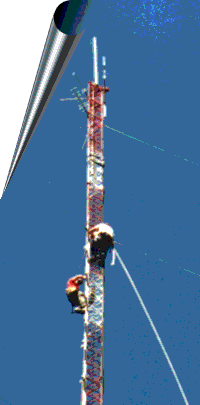 |
| The Evacuation Centres
Walking wounded and uninjured campers were quickly moved from the Green Acres campsite to the “Hub” community centre approximately 2 km north of the campsite and at a higher elevation than Pine Lake.
Laura Misik VE6LGM, Garry McCallum VE6PNQ and Mike Karp VE6MBK (all first aid trained) established Red Cross communications at the “Hub” community centres in support of Red Cross Registration and Inquiry and First Aid operations. Handheld VHF operations to the VE6QE repeater were marginally possible from this site. Extreme patience and clarity of communications by Net Control VE6BLD became essential under such poor signal conditions. Later in the night Ron DitchburnVE6DIT was able to get his car past the roadblocks and into the “Hub” site to provide high powered capability into the repeater network.
| Ground Zero
RAC Assistant Emergency Co-ordinator, Darren Misik VE6ZZM moved immediately to the main disaster site, established liaison with the site commander and set up a cross band repeater link in his car from 446.000 to the VHF input of the VE6QE repeater west of Red Deer. HF mobile equipment was held in reserve. Howard Biederman VE6FS helped VE6ZZM on site and then moved to the Red Deer College reception centre. |
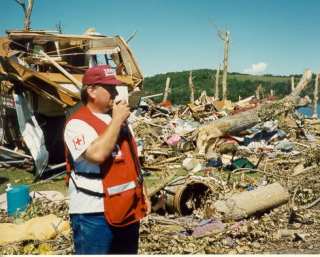 |
| Joel Wedder VE6VOX transported generators and then moved to the Red Deer College reception centre and established a VHF station at that site to link to Red Cross Red Deer.
Other amateurs John Malinic VE6HPY and Colin Gregor VE6GRO deployed with Search and Rescue to the same site and were not directly involved with the Red Cross operation but were able to come up on our frequencies when needed.
Earl Burneau VE6EPJ prepared the military response from the Cormack Armouries in Red Deer and was able to come up on amateur frequencies if needed.
As Red Cross teams began to arrive from Edmonton and Calgary, Registration and Inquiry phones were slowly handed over to Red Cross Volunteers and Staff. Continuous radio operations were maintained until the last of the evacuees had been transported to Red Deer reception centres after 3 AM on Saturday Morning.
Rotating shifts of amateurs began at 8:00 AM Saturday morning as some were sent home for some sleep before returning to both the Pine lake site and the Red Cross Office. |
| The Recovery PhaseMonday morning saw a change in the nature of the operation. Farmers along the tornado’s path had been impacted by everything from the loss of their homes and farm buildings to being unable to harvest crops due to debris that the tornado had dumped on their fields. Many crops are now ready to harvest. The farmers, who had largely been ignored during the rescue operations at the campground now became the focus of a massive volunteer effort to sweep the farms of tornado debris, restore power to farm equipment such as milking systems and help return livestock to the proper owners. |

The sheer force of a compact multi vortex tornado is demonstrated in this picture of debris in the Green Acres campground at Pine Lake, Alberta |
| Garry McCallum VE6PNQÂ logging traffic to VE6RCR at the Red Cross Office in Red Deer. The station handled traffic requesting the acquisition and delivery of food, water, ice, sunscreen and insect repellent to the hundreds of volunteers in the field from July 18 to July 21. |
 |
| Al Smith VE6OX owns a residence at the south end of Pine Lake less than 1 kilometre from the devastated campsite. Red Cross EC Garry Jacobs VE6CIA established a cross band repeater using the tower, antennas and solar panels at the VE6OX home location. This repeater provided a link to the VE6YX repeater east of Red Deer. Red Cross amateurs could then use 146.550 simplex on site and link to Red Deer Red Cross office on 444.550 using UHF equipment supplied by Dale Ferrel VE6NON. This system operated at the same time as the emergency net on VE6QE giving full coverage to the entire Pine Lake area. |
| Darren Misik VE6ZZM pictured practicing emergency communications under canvas near Elnora during International Field Day exercises. Just 3 weeks later Darren was co-ordinating Red Cross communications at the Pine Lake Tornado Disaster. The CARL club tents were used to shelter volunteers in the field. |
 |
| Amateur radio operations focussed on ensuring that volunteers in the field were supplied with food, water, sunscreen and insect repellent. C.A.R.L. club tents were erected in the fields for sun shelter. Amateurs provided safety communications in case of injury during the field sweeps and maintained constant communications with the Red Cross office in Red Deer. The Red Cross station VE6RCR was continuously operated by Sandra Jacobs VE6SND and Garry McCallum VE6PNQ for 12 hours each day from Tuesday until Friday. |
| Sandy Jacobs VE6SND operating the Red Cross control station VE6RCR during the Pine Lake Tornado operation. Sandy and RAC Central Alberta EC Garry Jacobs VE6CIA returned from the Glacier – Waterton Hamfest to help co-ordinate Red Cross amateur radio operations. |
 |
| Amateurs also provided assistance in the recruitment and transportation of supplies and specialty resources such as all terrain vehicles to the affected farms. Sue Getty VE6SJD spearheaded many of the supply recruitment and delivery operations along with Gary Stewart VE6SNL, Rod Martin VE6ROH and John Kostiw VE6ONE delivering the goods. Assistant EC Brian Davies VE6CKC, Bob King VE6BLD, Bill Guthrie VE6OLD and Laura Misik VE6LGM spearheaded the field support operations. These operations were still underway as of Saturday July 22. |
| RAC Assistant Emergency Co-ordinator, Darren Misik VE6ZZM (right) and Red Cross emergency co-ordinator Niki Dalton (left) survey the tornado damage at Pine Lake, Alberta, Canada.
Darren VE6ZZM was one of the first Red Cross amateurs on scene arriving with Laura Misik VE6LGM, Garry McCallum VE6PNQ, Mike Karp VE6MBK. Darren was one of the last amateurs to leave the devastated h |
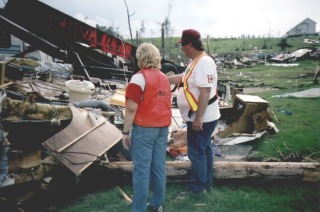 |
| Throughout this operation Central Alberta’s amateur radio operators were not only involved in communications but they threw themselves at non radio operations as well. These same people, their spouses and families were actively involved as community volunteers. Many simply shut down their businesses, took the week off work or squeezed relief operations in between work shifts. They aided the injured, answered phones, talked to the distressed, shuttled supplies, recruited donations and sometimes just offered a shoulder to cry on.
Garry McCallum
VE6PNQ
C.A.R.L. Newsletter Editor
|
| LeeAnne Shinski, Red Cross staff member, surveys the damage at the Green Acres Campground. Red Cross staff from the Red Deer, Alberta office were front line responders to Friday’s tornado. Hundreds of Red Cross staff, volunteers and amateur radio operators had been working on the disaster since early Friday evening. |
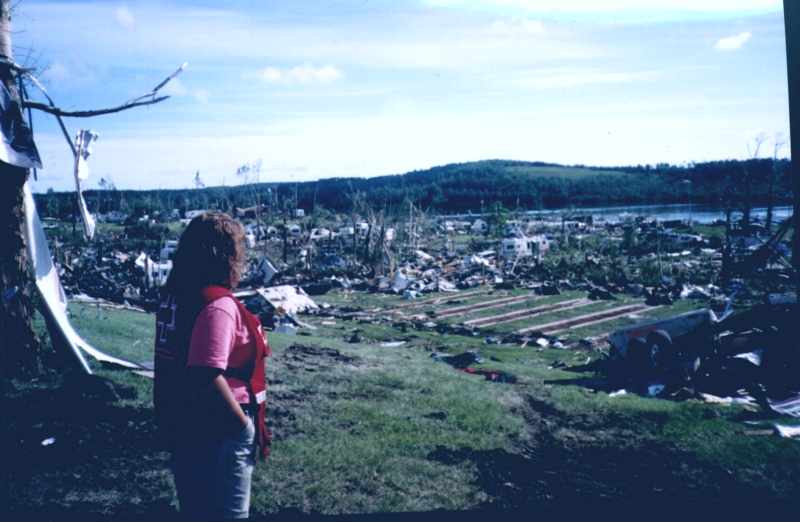 |
| For more information about Radio amateurs of Canada (RAC), and the Amateur Radio Emergency Service (ARES), connect to the RAC website www.rac.ca For a list of Alberta Emergency Coordinators connect to RAC at http://www.rac.ca/aresab.htm
For more information about the amateur radio services provided to the Red Cross by RAC read the MEMORANDUM OF UNDERSTANDING |
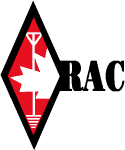 |
| For more information about the Red Cross response to the Pine Lake Tornado connect to the Red Cross web site. www.redcross.ca
Donations to the Red Cross Disaster Fund can be made on their web site or by calling 1-800-418-1111
Editors Note: The Canadian Red Cross has already collected enough money to cover the costs incurred during the Pine Lake Tornado. Those cost were incurred during the first few days of the disaster. The Red Cross was spending money on the victims of the Pine Lake Tornado within hours of touchdown. That money came from donations made prior to the tornado. Your further contributions will be set aside for the next crisis.
Disasters are “come as you are” events.
| Media Links |
Compiled by the Central Alberta Radio League (1955-2003), amateur radio communicators for the Red Cross response during the Pine Lake Tornado. |
| This page was a continuing work in progress that was first created within 24 hours of the tornado touching down July 14, 2000. The number of web sites that are maintaining stories about the Pine Lake Tornado gets less with every passing month as various news agencies purge their web sites of “old news”. Please notify the Central Alberta Amateur Radio Club webmaster via email: webmaster@caarc.ca of any “dead links” or “404” errors that you may find on this page and we will delete them |
| RDTV Video Tape – “Tornado Tragedy at Pine Lake” – (60 mins) available from RDTV for $19.95 email rdtv@rdtc.wic.ca or mail check to RDTV 2nd Floor 2840 Bremmer Avenue, Red Deer, Alberta, T4R 1M9
This is the best compilation of news video about the Pine Lake Tornado that we have seen. |
| Halifax Herald |
‘Miracle baby’ virtually unscathed after three-storey toss |
Satellite Imagery
University of Wisconsin
|
|
GOES-10 10.7 Micrometer IR Pine Lake, Alberta Tornado – July 14, 2000 |
|
|
|
GOES-8 Visible Channel Pine Lake, Alberta Tornado – July 14, 2000
| Pine Lake Tornado Responders |
| Responder VE6MIM Mike Mailhiot |
| Unless you are an amateur radio operator or you live in Oriole Park, Red Deer you probably don’t know who Mike Mailhiot is. His neighbors may know him as “the guy down the street with the big antennas on his house”. Not all of them are entirely pleased with the height of his antennas but most of his neighbors are supportive of his amateur radio hobby and the public service that Mike provides.As a member of CFARS (Canadian Forces Affiliate Radio System) Mike has worked on the Y2K project, passed personal messages to Canadian troops overseas, been involved in the Amateur Radio Emergency Service, and was one of the first amateur radio operators to establish contact from his home in Red Deer to amateur radio operators arriving with Search and Rescue at the Pine Lake Tornado Disaster. |
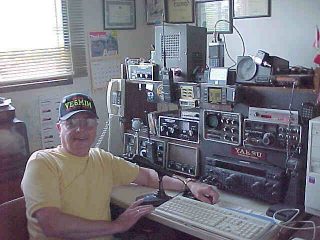 |
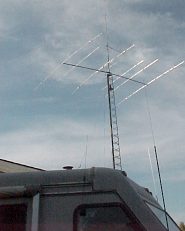 |
During the first hours of the Red Cross deployment to Pine Lake Mike moved radio equipment from his home to the Red Cross offices in Red Deer where he operated throughout the night organizing teams to answer phones, operating radios and performing instant Registration and Inquiry training to incoming volunteers. He left his daughter, Tara VE6TMM, to operate the radios at home.When Red Cross operations shifted from emergency response to recovery operations Mike donated the use of his radio equipped motor home as a base of operations on a farm near the Pine Lake tornado site. |
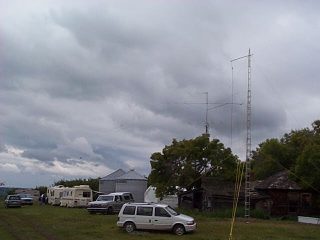 |
| Mike Mailhiot VE6MIM established the emergency VHF station at the Red Deer offices of the Canadian Red Cross and began recruiting amateurs to aid the Red Cross by manning the phones and radios. In the initial hours the Red Cross staff and volunteers were overwhelmed. Many amateurs who responded never touched a radio because they were needed to answer phones at the Red Cross office and relay messages to the radio room. The Red Cross office was initially operated by one Red Cross volunteer, amateur radio operators VE6MIM, VE6SJD,VE6JHG,VE6KEN,VE6NTT and others whose names got lost in the confusion. Some were simply driving down Highway 2, heard the call on VE6QE and stayed the entire night. |
| Mike has been a key organizer of the Red Deer / Three Hills component of an annual International amateur radio training exercise known simply as “Field Day”, an event where amateur radio operators around the world practice emergency mobile communications. This year the event was held June 23, 24, 25 with the Central Alberta amateurs parked in a field just a few miles south of the Pine Lake Tornado Disaster site. Many of the people who were practicing emergency communications at Field Day were the same people who provided communications during the Pine Lake tornado disaster. It pays to practice.Thursday night, 6 days into the Pine Lake tornado disaster, a violent thunderstorm moved across north Red Deer. Lightning struck the Mailhiot house, destroying all of the communications equipment pictured at the top of this page. Damages to his communications equipment are estimated to be in excess of eighteen thousand dollars.
Mike VE6MIM was there when the people of Pine Lake needed him. Hopefully his insurance company will be there for Mike and his family when they need help replacing a resource that was invaluable during the tornado. |
| Amateur Radio Operators who answered the call (as listed in net control logs, in no particular order) |
| VE6VOX – Joel Weder – Olds |
VE6DIT – Ron Ditchburn – Innisfail |
VE6TCO – James Currie – Elnora |
| VE6EJS – Edward Szymanek - Eckville |
VE6PNQ – Garry McCallum – Red Deer |
VE6LDM – Douglas Matheson – Red Deer |
| VE6NM – Earle Smith – Grande Prairie |
VE6RLA – Richard Astle – Olds |
VE6ALE – David Mathews – Elnora |
| VE6LGM – Laura Misik – Red Deer |
VE6MM – Dick Krogman – Red Deer |
VE6GRO – Colin Groeger – Red Deer |
| VE6MIM – Mike Mailhiot – Red Deer |
VE6JCL – Phillip Calderbank – New Norway |
VE6QA – James McGrath – Red Deer |
| VE6TMM – Tara Wade – Red Deer |
VE6NTT – Donald Sipes – Calgary |
VE6CLY – Cyril Hughs – Elnora |
| VE6KEN – Ken MacDonald – Elnora |
VE6DJC – Doug Corrigan – Lacombe |
VE6SJD – Susan Getty – Clive |
| VE6JHG – Jim Getty – Clive |
VE6TRL – Tammy Higginbottom – Elnora |
VE6SNL – Gary Stewart – Red Deer |
| VE6LHW – Leslie Worrall -Â Edmonton |
VE6HPY – John Malinic – Red Deer |
VE6ZZM – Darren Misik – Red Deer |
| VE6SV – Gordon Kosmenko – Sherwood Park |
VE6ROH – Rod Martin – Red Deer |
VE6BLD – Bob King – Lacombe |
| VE6PMX – Peter Wilkinson – Olds |
VE6WCE – Gerald Welch – Sylvan Lake |
VE6CKC – Brain Davies – Innisfail |
| VE6MRK – Archie Merkley – Red Deer |
VE6CRY – Patrick Carey – Red Deer |
VE6CMQ – Shirley Hughes – Elnora |
| VE6BLD – Bob King – Lacombe |
VE6CHU – Cecil Friesen – Red Deer |
VE6CIA – Garry Jacobs – Red Deer |
| VE6SND – Sandra Jacobs – Red Deer |
VE6ONE – John Kostiw – Red Deer |
|
|
|
|
| Red Cross Stations |
Search and Rescue |
Additional Assistance |
| VE6RCE – Red Cross Edmonton |
VE6HPY – John Malinic – Red Deer |
VE6OX – Al Smith – Pine Lake |
| VE6RCR – Red Cross Red Deer |
VE6GRO – Colin Groeger |
VE6BCA – Brian Crisall – Ednonton |
| VE6RCC – Red Cross Calgary |
VE6JDK – David Dick – Edson |
The BEAR group (Balloon Experiments with Amateur Radio, Edmonton Area) |
|
|
|
 |
 |
 |
 |
 |
| VE6PNQ – Garry |
VE6MIM – Mike |
On site |
VE6BLD – Bob |
VE6SND – Sandy |
How the Pine Lake Tornado Image
was Created.
by Andrew Stark, Calgary
|
| (Copy of email from Andrew Stark to Garry McCallum VE6PNQ)
Subject Re GEOS 8 Tornado image
Hi back Garry,
Where to begin … I am an amateur meteo-buff in Calgary. The afternoon of the tornado I was monitoring the Nasa Global Hydrology and Climate Center website wwwghcc.msfc.nasa.gov
Anyone who is interested should have this site bookmarked. One can acquire fairly up to date Goes shots in IR, Visible or Water Vapor (as I’m sure you know). It allows one to zoom in, and animate up to 30 frames of history (at 15 minute increments). Delightful for ‘armchair storm chasers’. I knew things were becoming extremely volatile in the Penhold and Red Deer area, so I captured and saved to disk, several visible images over an hour or so. When the news came over the radio, of the disaster at Pine Lake, I reviewed the captured picture closest to the time reported. The super cell was cleary visible from my window here in Calgary. I opened the picture in Adobe Photoshop to have a closer look as it was hard to believe I was seeing such violent outflow from so far above. By using the array of filters and sharpening tools in Adobe, I had no doubt. I grabbed a map of the Pine Lake area, from the Net, and scaled it and lined it up roughly to the longitude. Then I cut the piece out of the Goes picture and zoomed and scaled that, and put everything back on the page. This was all done winging it with a ruler and an ‘eyeball’.
Sure, please use this public information. I don’t mind you referring to me at all. The credit, though, sure seems to belong to Nasa! The graphics part I do as a sideline in my work.
I deeply admire what you folks do. So often you are the front line of vital public information, and assistance. I appreciate your compliment and think I’ll follow your website from now on.
Sincerely,
Andrew Stark |
|
|
GOES-10 Visible Channel Pine Lake, Alberta Tornado – July 14, 2000
|
|
|
|

